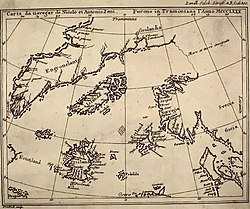Frisland
This article needs additional citations for verification. (January 2018) |


Frisland, also called Frischlant, Friesland, Frislanda, Frislandia, or Fixland, is a phantom island that appeared on virtually all of the maps of the North Atlantic from the 1560s through the 1660s. It was removed as no Frisland was found as the area was more thoroughly explored and navigation increased. Accurate navigation was more difficult in this time (before more accurate Marine chronometers), and it might have originated from a misidentification of Iceland or Greenland.
History
[edit]

Frisland is first mentioned In 1558 when Nicolò Zen the younger published a series of letters and a map entitled On the Discovery of the Island of Frislanda, Eslanda, Engroenland (sometimes Engroneland), Estotiland & Icaria, made by two Zen Brothers under the Arctic Pole which he claimed to have discovered in a storeroom of the family's home in Venice. The letters and map purported to describe a voyage in the northern Atlantic undertaken by his ancestors, Nicolò and Antonio Zeno, in the 1390s.[1] After this incorrect charting, the phantom island appeared that way on maps for the next 100 years.[2] Its existence was given currency in manuscript maps of the 1560s by the Maggiolo family of Genoa, and the island was accepted and reproduced by cartographers Gerardus Mercator and Jodocus Hondius. Some early maps by Willem Blaeu, such as his 1617 map of Europe, omit it, but it reappeared on his 1630 world map as one of many islands shown off the eastern coast of Labrador, which was then believed to extend to within a few hundred miles of Scotland. It also appeared on a 1652 world map by Visscher, largely copied from that of Blaeu. The 1693 Vincenzo Coronelli map places it close to Greenland.[3] Even in the mid-18th century, explorers' maps clearly depicted Frisland as separated from Greenland by a wide strait.
The myth of Frisland was gradually dispensed with as explorers, chiefly from England and France, charted and mapped the waters of the North Atlantic.
Depiction
[edit]Frisland was shown as a roughly rectangular island, with three triangular promontories on its western coast.
In some mappings, it is identified as "Fixland".[4] (Matteo Prunes map of 1553, from Library of Congress, see upper right of map; see also,[5] page 88 for other clearer source; see also Catalan map of 1480 showing "Fixland";[6] original source map copied in this article, page 64.[5])
See also
[edit]- Buss Island (mid-atlantic phantom island, late 1500s to early 1800s)
- Estotiland (Another phantom from the Voyage of the Zeno brothers)
- Martin Frobisher (English sailor who claimed to have seen Frisland)
- Atlantis (alleged lost island city of antiquity)
- Azores (actual islands in the Atlantic)
- Faroe islands (another set of actual islands in the North Atlantic in between Iceland and the U.K)
- Shetland (islands between Faroe and Orkney, Scotland)
- Baffin Island (an island west of Greenland)
- Mid-Atlantic Ridge
- Jan Mayen (real but uninhabited island north of Iceland)
- Svalbard (real island east of Greenland and north of Norway)
- Bear Island (Svalbard) (real island near Svalbard)
- Doggerland (a real but now submerged land in north sea)
- Early Holocene sea level rise
References
[edit]- ^ Smith, Brian (3 January 2022). "Earl Henry Sinclair's fictitious trip to America, by Brian Smith". New Orkney Antiquarian Journal. 2. Retrieved 14 April 2025.
- ^ "Frisland, an Italian Fabrication in the North Atlantic". Big Think. 23 July 2010.
- ^ "Chart of the Mediterranean, Black Sea, and the coasts of western Europe and northwest Africa". Library of Congress.
- ^ a b Babcock, William Henry (16 June 1922). "Legendary islands of the Atlantic; a study in medieval geography". New York American Geographical Society – via Internet Archive.
- ^ "Newfoundland Maps". 2 January 2018. Archived from the original on 2 January 2018.
Further reading
[edit]- Ramsay, Raymond (1972). No Longer on the Map. New York: Viking Press. pp. 53–76. ISBN 0-670-51433-0.
